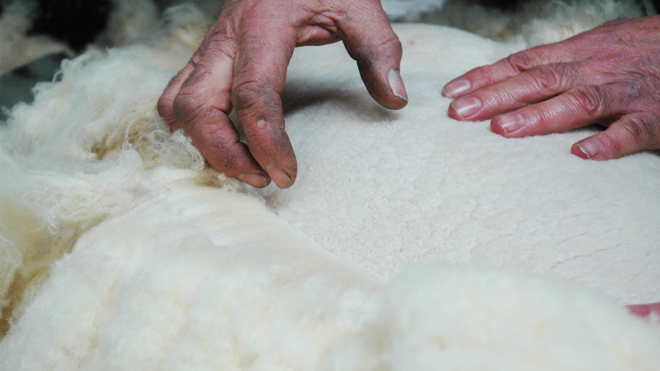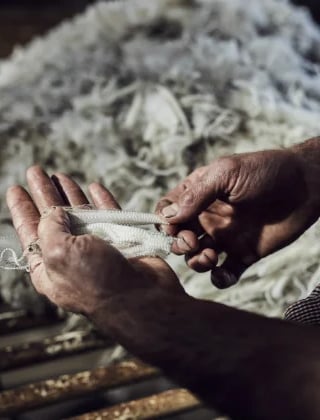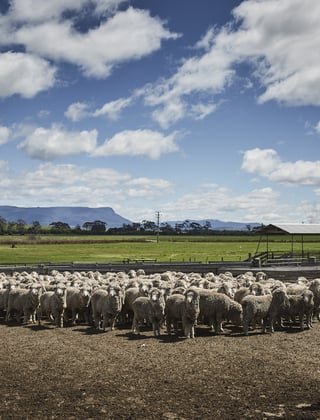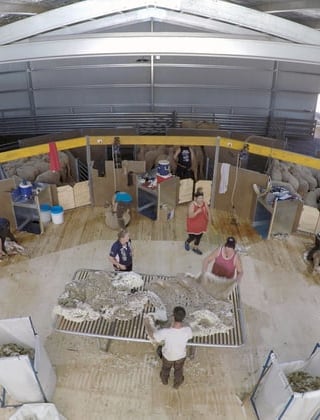Biological harvesting update

AWI is funding promising research into a new opportunity for biological harvesting of wool that generates a weakened zone at the base of the wool fibre but, importantly, enables the fleece to stay on the sheep without a net until the wool can be removed.
Wool fleece after treatment using biological defleecing at the University of Adelaide.
AWI is funding promising research into a new opportunity for biological harvesting of wool that generates a weakened zone at the base of the wool fibre but, importantly, enables the fleece to stay on the sheep without a net until the wool can be removed.
Many woolgrowers will have heard of Bioclip®, a biological defleecing process developed by CSIRO and made available in the 1990s, which allowed wool to be harvested without the use of a mechanical handpiece. To harvest the wool, sheep are given a single vaccination of Epidermal Growth Factor (EGF) that causes a break to occur in the wool fibres. However, a net has to be placed over the sheep and fleece into which the fleece is shed about one week after the sheep is injected.
It works, but there was little take-up by woolgrowers, mainly because the putting on and removal of the nets from the sheep made it a labour-intensive process.
However, a new AWI-funded project with the University of Adelaide is investigating a new way of biological wool harvesting that enables the fleece to remain on the sheep, without the need for nets, until the wool is mechanically removed.
Chief researcher Professor Phil Hynd of the University of Adelaide says the new project takes a biological approach that is different to Bioclip®.
“Previous attempts at biological wool harvesting concentrated on temporarily stopping wool growth, which resulted in fleece shedding. In contrast, the new approach is aimed at creating a weakened zone of wool next to the sheep’s skin, which enables the fleece to stay on the sheep for several weeks,” Professor Hynd said.
“Wool will continue to grow beneath the weak point, so as to protect the sheep from hypothermia and sunburn after the fleece above the weak point is harvested. You can harvest the wool above that weak point for a time after treatment (from say two to ten weeks) that is convenient for the woolgrower.
“Wool does not fall off in the field despite the weak point having very low staple strengths of less than 10N/kTex. While each staple is weak, when combined with others the total force to break them all is relatively high. This is very important because it means that we can now aim treatments to reduce staple strengths to very low levels which will ensure that all treated sheep are harvestable.”
“It has been demonstrated that the fleece does not break off the sheep into the paddock under normal grazing conditions”
- Professor Phil Hynd, University of Adelaide

Professor Phil Hynd of the University of Adelaide who is leading the researchers on the biological harvesting project.
A small AWI-funded trial has already been undertaken by the University of Adelaide in which the fleece did not fall off in the paddock under normal grazing conditions for up to ten weeks after the treatment was administered.
Work is being undertaken to determine whether the treatment works on cross-bred and composite sheep as well as Merino sheep. This is because, while the researchers know the treatment will provide a weak point on all fibres that are growing at the time of treatment, a proportion of wool of crossbreds/composites doesn’t actually continually grow and can be in a ‘resting phase’.
The new project will look at administering the treatment via an injection, rather than via feeding where there is the potential problem of ‘shy feeders’ not receiving a sufficient ‘dose’, and also differences in gut function between sheep.
“We are working on a subcutaneous injectable and we believe that we should be able to dial up quite accurately the N/kTex that we require. The injected dose would be based on body weight, in a similar manner to how doses are calculated for drenching,” Professor Hynd said.
Mechanical harvesting
The weakening of the fibres is to such an extent that a removal device will break the fibre at the weak point and remove the fleece without the need for cutting equipment. AWI will seek proposals to develop mechanical/automated solutions to harvest weakened wool from engineers and researchers.
The University of Adelaide is already looking at developing a device to harvest the wool in the most efficient and labour-saving way possible.

Dr Sarah Weaver who is part of the University of Adelaide team of researchers.
“We already have a good idea from earlier research of the type of removal device that could work. Our engineers came up with a very simple hand-held device that has a spinning drum with little fingers on it that just break the fibres at the weak point and the sheep doesn’t feel anything,” Professor Hynd said.
“It can be operated by unskilled labour. They just run the device at pretty high speed across the sheep and the wool just peels off in front of the device. It could be possible to mount a vacuum system on the front of the device which will then suck the wool off away from the sheep.
“The real breakthrough would be automating the process so that wool can be harvested very quickly from large numbers of sheep in a high throughput system with very low labour input.”
“It is possible to create a weakened zone of wool and remove the fleece above the weak point using a non-cutting ‘wool-breaking’ device.”
- Professor Phil Hynd, University of Adelaide
Compared to traditional shearing, biological wool harvesting will improve wool quality by eliminating skin pieces, second-cuts (thereby resulting in even fibre length) and creating slightly reduced fibre diameter at the tips. Health and safety issues around sharp handpieces would be eliminated and animal handling injuries could be minimised through the use of upright platforms or conveyor belts.
Next steps
Professor Hynd says the researchers understand the urgency of the wool industry needing an alternative to conventional shearing and they are working flat out to provide one.
“While things look promising, biological harvesting is not a trivial thing to do; people have been trying to do this for decades. But we’ve made some big steps and I can say to growers that we’re confident that this is a good approach, we’re confident that we can make a weakened zone in the wool and we’re confident that we can get it off without a comb and cutter,” Professor Hynd said.
“While there is still plenty of work to be done, we feel excited about the potential benefits that this new method of biological harvesting could have for the wool industry.”
- Professor Phil Hynd, University of Adelaide
“Now we need to go through the careful methodical scientific steps to make sure that we do it properly and that always takes time. But in 18 months’ time, we want to be able prove that our agents will reliably and repeatably create a weak point in sheep – and we will be working towards optimising the dose, optimising the way it’s injected, and the form it’s injected. By then, our engineers hopefully will have progressed towards a commercial system that will remove the wool.
“We’ve then got a lot of work to do once it’s in a prototype field demonstration stage – for example, we’ve got to work through body weight types, different environments, different sheep types, check it has no effect on pregnant sheep or general health; so far it looks pretty good, but we’ve got all that work to do.
“I have a great team working with me on this project including Dr Sarah Weaver who started the early work with me on the idea many years ago. We work very closely with the AWI team to ensure we remain focussed on the best outcomes for the wool industry.”
Providing options for woolgrowers
The new AWI-funded project continues years of collaboration with the University of Adelaide on this type of research. It is an example of the multi-pronged approach that AWI is now taking to make wool harvesting easier and more cost-effective for woolgrowers and the industry.
“The biological harvesting project is very timely and has the potential to be a game-changer for wool harvesting,” said AWI Chairman Jock Laurie.
“It is critically important for the industry because we need to provide growers with new harvesting options. Times of pressure in industries drive change and that is exactly where we are with the wool industry right now.
“It might not be for everyone, but we need to provide choices for woolgrowers about how they remove their wool efficiently and safely.”
- Jock Laurie, AWI Chairman
“We have seen enough potential in this project so far to believe it provides a great opportunity for the industry. At this stage, I can say it is very positive and I hope this gives confidence to the industry that AWI will continue to drive and invest in this work.”
More information: Hear more from Professor Hynd in Episode 244 of AWI’s The Yarn podcast at www.wool.com/podcast
This article appeared in the June 2023 edition of AWI’s Beyond the Bale magazine. Reproduction of the article is encouraged.















